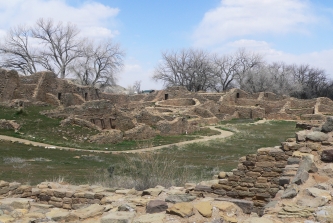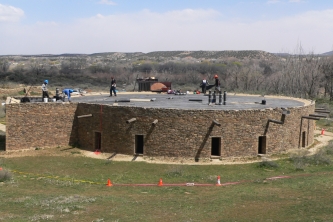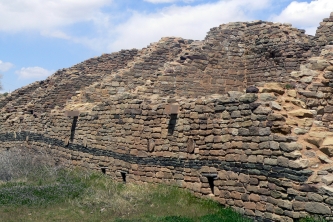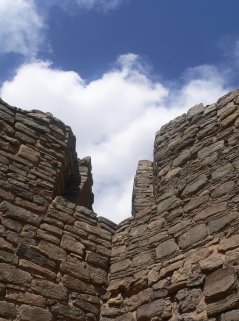NPS Website; Local Website
 WHAT IS IT?
WHAT IS IT?11th Century ancestral Puebloan ruin influenced by the dominant architectures of the earlier Chacoan style and the later Mesa Verdean style. The Site is home to a massive reconstructed Great Kiva.
BEAUTY (7/10)
Aztec Ruins is located in the town of Aztec, N.M. down a side street and across from a school. Given its pedestrian location, this ancient masterpiece might as well be a warehouse or an office complex. The Park, a UNESCO World Heritage Site (named as a part of the greater Chaco Culture), still stands in a rural population center much as it did 1,000 years ago.
The reconstructed Great Kiva is currently undergoing some repair. During our visit, a team of construction workers were milling about on its roof, laying tar and running heavy machinery. Yellow caution tape and orange cones directed the tourist around the workers. The presence of modern-day construction workers laboring around a 1,000-year-old place of worship was oddly thought provoking. As in, we had no idea what to think.
The West Ruin (the only fully excavated and accessible ruin) was strikingly beautiful with its grey and green intricate sandstone masonry. The complex’s short doors led to numerous nooks and passageways. Walking around the building felt like being a mouse scurrying through the maze. The Ruin Plaza was covered in green grass and purple wildflowers. It felt like a city park and differed greatly from the dusty world of Chaco Culture NHP to the south.
The Great Kiva is the star of the Monument. It was excavated in 1921 and rebuilt in 1934. Four columns three feet square rise 18 feet to support a massive, flat, circular roof of approximately 90 tons in weight. Said roof was the topic of repairs. The room itself is 41’3.5” wide at floor level and 48’ 3.5” wide at a height of 3 feet above the floor.
 NPS policy no longer allows for reconstructions of historic structures. But as we crawled down the ladder and into this massive room lit only by natural light, we were grateful for the experience that this reproduction provided.
NPS policy no longer allows for reconstructions of historic structures. But as we crawled down the ladder and into this massive room lit only by natural light, we were grateful for the experience that this reproduction provided.The symmetry and simplicity of this room accents its size. The room is cool and clean; its thick walls and roof nearly blocked out the sounds of the workers above us. It is not difficult to imagine people retreating to this space to worship, work or simply separate themselves from the hustle and bustle above ground.
HISTORICAL INTEREST (6/10)
19th century travelers to the region misnamed Aztec Ruins NM, like so many other Southwest U.S. pre-Columbian sites. Aztecs never lived in the area; their empire reigned over central Mexico. Ancestral Puebloans were the actual inhabitants of the Aztec Ruins NM site over 1,000 years ago.
The Site is closely related to the earlier Chacoan culture of the south and the later Mesa Verdean culture to the north. It serves as a halfway point between the two chronologically, historically, architecturally and geographically. Archeological and present-day visual evidence of the ruins displays things at Aztec visible at Chaco and not at Mesa Verde and vice versa.
CROWDS (6/10)
There were a few families wandering around the Park with us. They did not affect our visit, but they all seemed very interested.
EASE OF USE/ACCESS (1/5)
After traveling down a 21-mile dirt road to leave Chaco Culture NHP, Aztec Ruins NM feels decidedly urban; the ruins are in “downtown” Aztec, N.M. Only in retrospect do you realize that Aztec only has a population of 5,700 and the nearby metropolises are Farmington and Bloomfield. The closest Interstate is at least two and a half hours away but somehow Verizon cell service is strong. I think our ultimate determination of rural-ness is if we can use our phones.
 The most relevant geographical locator for Aztec Ruins NM is that it is about halfway between Chaco Culture NHP and Mesa Verde NP and sits on U.S. Route 550. The only probable way you will be in Aztec is if you are traveling between those two more famous World Heritage sites.
The most relevant geographical locator for Aztec Ruins NM is that it is about halfway between Chaco Culture NHP and Mesa Verde NP and sits on U.S. Route 550. The only probable way you will be in Aztec is if you are traveling between those two more famous World Heritage sites.Another fun reference point is the wonderful old west town of Durango, Colo., located 34 miles to the north. Durango is home to the scenic Durango-Silverton Railroad and a large selection of good restaurants. Durango’s big city feel belies its relatively small population and remoteness.
CONCESSIONS/BOOKSTORE (3/5)
The slight selection of books available at Aztec Ruins NM is redeemed by its unique inclusion of a few classics of modern Native American Literature, namely Lesley Marmon Silko’s Ceremony and N. Scott Momaday’s House Made of Dawn.
COSTS (3/5)
The Site costs $4 per adult, free with the National Parks Pass.
RANGER/GUIDE TO TOURIST RATIO (4/5)
The Rangers that were posted at the welcome desk greeted us with big smiles and a helpful spirit. They immediately offered us the house copy of the self-guided trail booklet ensuring that our walk around the ruins would be enjoyable. There are no Ranger-led tours of the ruin, interpretive talks may begin again during the tourist high-season, Memorial Day through Labor Day.
TOURS/CLASSES (7/10)
We really appreciated the self-guided trail booklet. It is available for purchase for $0.50 but the Ranger staff provides a returnable copy for your use. The Aztec Ruins Rangers have enlarged the house copy onto bigger paper. The booklet has also been laminated and bound, especially helpful during our windy visit.
Given the Park Service’s chronic short staffing and sporadic crowds, we understand the difficulty of providing Ranger tours to every visitor. These self-guided trail booklets have become a staple in the southwest and are, as a rule, enjoyable and educational. Nonetheless, we think it is vital that the Park have Rangers on duty, like at Aztec Ruins NM, to answer any questions that the booklet could not clarify.
The film does not specifically cover Aztec Ruins NM; instead, it looks at the big Ancestral Puebloan picture. A number of sites in the Four Corners region also offer this film. In the words of a Ranger, “It gets around.” We enjoyed it, however, wishing that more NPS films would approach the local area with the same sense of scope.
 FUN (7/10)
FUN (7/10)There is nothing taxing about touring Aztec Ruins NM. Directions to the Site are simple. Parking was not a problem. Walk in, ask to see the movie. Chat with the Ranger. Peruse the bookstore. Get a laminated booklet and head outside to see the Ruins and Great Kiva. Come back inside, ask some questions, then head back to the wonderful Rocky Mountain town of Durango, Colorado for some dinner. We had a lovely day; odds are you will too.
WOULD WE RECOMMEND? (7/10)
There are a number of reasons you might be traveling in the Four Corners region. Both Mesa Verde NP and Chaco Culture NHP are destination sites; they may be the centerpiece of your Ancestral Puebloan odyssey and require more than a single day’s visit. Aztec Ruins NM is a must-see on the way between these two sites and a nice companion piece to Mesa Verde NP if Chaco’s unpaved dirt road is not your thing. It can be also be toured in less than two hours, if you are looking for a nice, sweet diversion from your stay in Durango, Colorado.
We highly recommend Aztec Ruins NM, but only if you are already in the area.
TOTAL 51/80
www.usa-c2c.com
© 2005